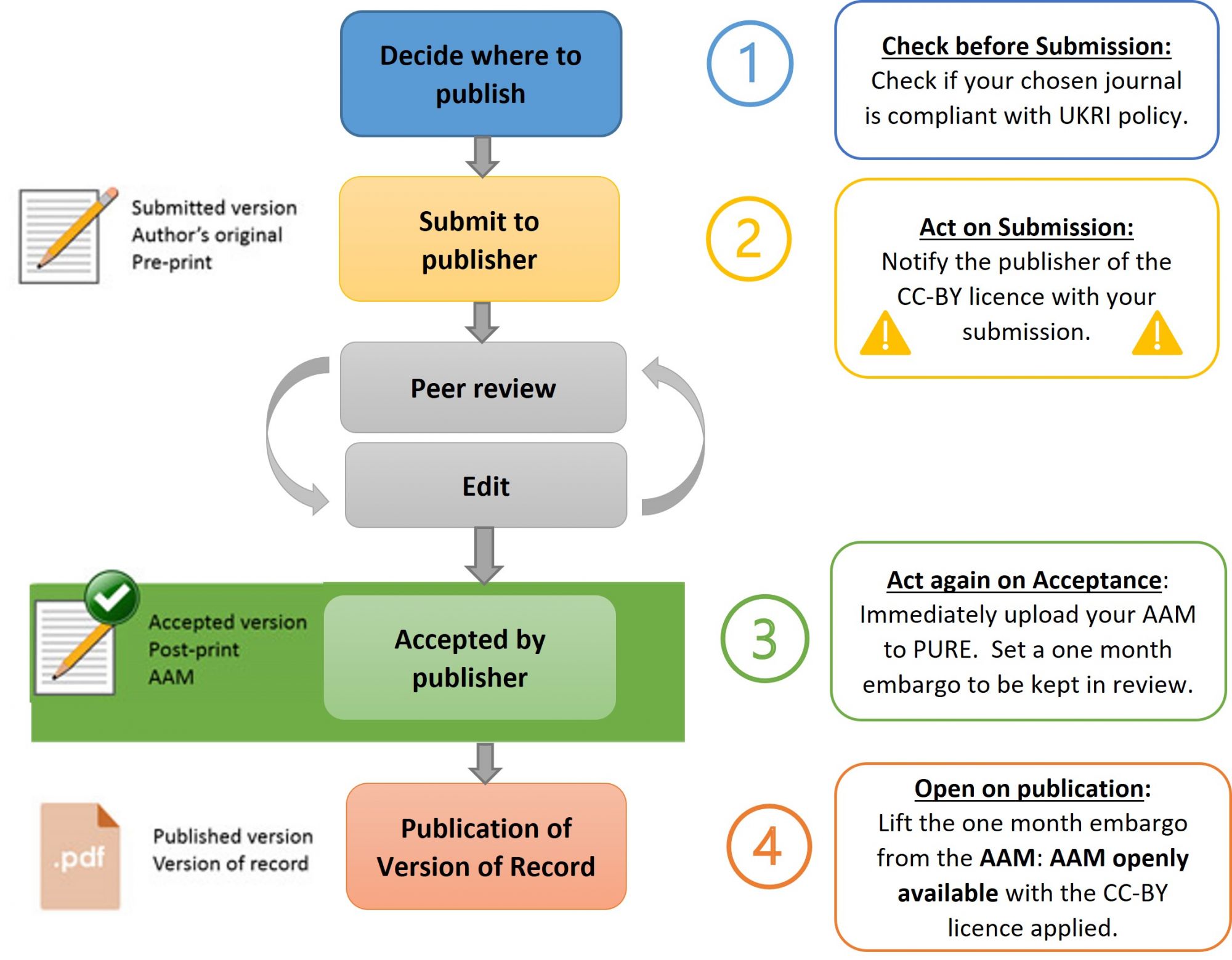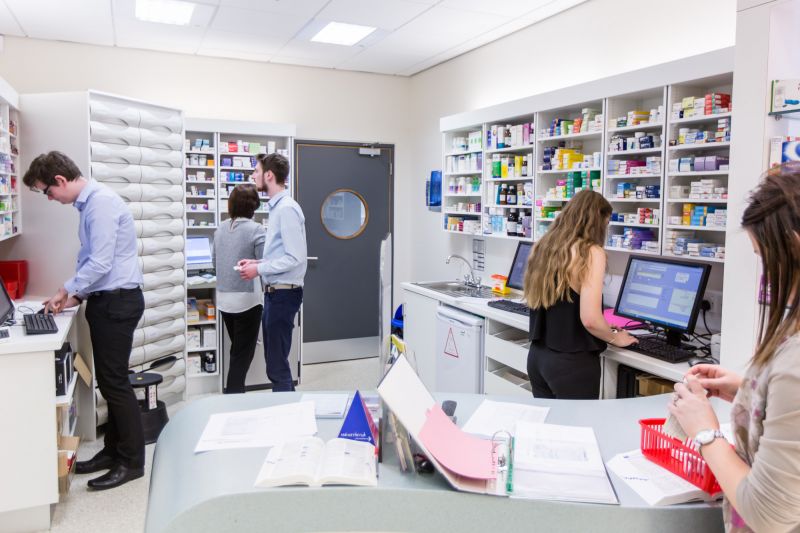Page content
Step One
Make your Accepted Author Manuscript (or Version of Record, where the publisher permits) freely available in PURE at the time of final publication.

Upload your Author Accepted Manuscript
You must continue to 'Act on Acceptance' by uploading your Author Accepted Manuscript into PURE immediately on acceptance.
Route 1
Publish the research article open access in a journal or publishing platform which makes the Version of Record immediately open access via its website:
- Publish in a fully Open Access Journal: good quality peer-reviewed Open journals are listed in the Directory of Open Access Journals (DOAJ).
- Publish in a journal covered by one of our Read and Publish agreements which allow Ulster authors to publish open access at no additional cost.
Route 2
Publish the research article in a subscription journal and deposit the Author’s Accepted Manuscript (or Version of Record, where the publisher permits) in an institutional or subject repository at the time of final publication.
From concept to publication there are four key action points for Open Access compliance:
Infographic on four key actions for OA

ACTION POINT 1.
Check before Submission: check if your chosen journal is compliant with UKRI Open Access policy
Before submitting your article check which publishers will allow immediate open access of the Author Accepted Manuscript (AAM) in repositories with a CC BY licence.
Working through Jisc, UKRI have contributed to the development of the cOAlition S Journal Checker Tool (JCT). Authors can use the JCT to check whether their preferred journal supports compliance with the policy and whether publishing in it is eligible for UKRI funds. cOAlition S will continue to refine and improve the JCT in response to feedback. They have also developed a small set of FAQs on the tool. The JCT seeks to provide an overview of any compliant 'routes' through which to publish articles.

Journal Checker Tool
Either as an alternative to the Journal Checker Tool, or as additional support, you can also use the following sources to check whether your journal is compliant:
| Dataset | Description | Link to the dataset |
|---|---|---|
‘Transitional Agreements’ or ‘Transformational’ or ‘Read and Publish’ Agreements | Ulster has a series of Read and Publish Agreements, which depending on the publisher, allow either unlimited Open Access or they have a capped number of articles. Read and publish (R&P) agreements seek to transition spend from paying for paywalled/subscription access to pay for reading and open access (OA) publishing services. | |
| Transformative Journals | A Transformative Journal is a hybrid journal that has committed to transitioning to OA (and fulfils the criteria set by JISC on behalf of UK research organisations). | |
Sherpa Romeo | If a journal does not fulfil criteria for the 2 datasets above, it might still welcome self-archiving of the AAM on terms agreeable to UKRI. | Search for the journal title, then review Journal Policy. |
ACTION POINT 2.
Act on Submission: notify the publisher of the CC BY licence at the point of submission of the article
From 1 April 2022 all UKRI-funded article submissions MUST include the following statement in both:
- the funding acknowledgement section of the manuscript
- any cover letter/note accompanying the submission.

Example
For the purpose of open access, the author has applied a ‘Creative Commons Attribution (CC BY) licence' to any Author Accepted Manuscript version arising.
Where permitted by UKRI, 'Open Government Licence' or 'Creative Commons Attribution No-derivatives (CC BY-ND) licence' may be stated instead but this must be applied for on a case-by-case basis.
Licensing Exceptions
There are two exceptions to this licensing requirement:
- An Open Government Licence (OGL) can be used when a research article is subject to Crown Copyright.
- UKRI may permit, on a case-by-case basis, the use of a more restrictive Creative Commons Attribution No-Derivatives (CC BY-ND) licence for the open access version of a research article.
Given concerns raised by humanities and social sciences stakeholders that a CC BY licence could enable misquoting and/or misuse of some research (particularly on sensitive topics) an exception permitting CC BY-ND (no derivatives) licence can be applied for. A CC BY licence is appropriate in most cases, but you can apply for an exception to use a CC BY-ND licence if you think this is needed.
ACTION POINT 3.
Act again on Acceptance: IMMEDIATELY upload your Accepted Author Manuscript to PURE
IMMEDIATELY upload your Author Accepted Manuscript to PURE.
Set a one month embargo to be kept in review, effectively closing the Author Accepted Manuscript until the Version of Record is published.
ACTION POINT 4.
Open on Publication: as soon as the Version of Record is published, the Accepted Author Manuscript must be made openly available in PURE and unrestricted to view and download.
Lift the one month embargo from the Author Accepted Manuscript. Set public access to the Author Accepted Manuscript to 'open' and select a CC BY Licence. A publisher-requested delay or ‘embargo period’ between publication of the Version of Record and open access of the Author Accepted Manuscript is not permitted.
Step Two
Include a Data Access Statement, even where there are no data associated with the article or the data are inaccessible.
Include a statement to inform readers where the underlying research materials associated with a paper are available, and how the research materials can be accessed. The statement can include links to the dataset, where applicable and appropriate.

Data Access Statements
Data Access Statements are required even if there are no data associated with the article or the data are inaccessible.
Underlying research materials are research data as defined in the Concordat on Open Research Data and can include code, software, numerical scores, textual records, images, sounds, objects and manuscripts.
Further guidance

We recommend including a data accessibility statement either in a section provided in the article template from your journal or as a sentence within the acknowledgements section and also include the citation in the list of references as described below:
“The research data [supporting/ underpinning] this publication can be accessed at [DOI] [reference number]”
For example:
The research data supporting this publication can be accessed at https://doi.org/10.21251/5dc06676-a5e9-4312-81f0-b3e1b0e00fe3 [39].
References: ...
[39] Watterson, Steven; Shukla, Priyank; McClean, Paula; (2021). Multimorbidity in the UK Biobank and its change over time. Ulster University. https://doi.org/10.21251/5dc06676-a5e9-4312-81f0-b3e1b0e00fe3.
Please note that some journals might have specific guidelines regarding the formatting and wording of data access statements and where they should be included. Authors should check these guidelines to ensure that their datasets are cited correctly.

- Data is provided as supplementary files on the journal website:
"All data supporting this study is provided as supplementary information accompanying this paper." - Data has been submitted to a discipline-specific archive (without a DOI):
"All reads are publicly available and have been submitted to the European Nucleotide Archive with the ENA accession number PRJEB28455 at https://www.ebi.ac.uk/ena/data/view/PRJEB28455" - More than one digital output exists:
"Gene expression data are publicly available under GenBank accession number [ACC NUMBER] at [URL]. Computational code for data processing is available at the Ulster University Research Portal at [DOI]." - Secondary data was used or re-analysed:
"This study is based on the re-analysis of existing data, which is openly available and cited in the manuscript. Additional documentation on data processing and analysis are available at the Ulster University Research Portal at [DOI]." - Sensitive data:
"The raw data underpinning this study cannot be made publicly available due to ethical concerns. An anonymised dataset and further information about the data and conditions for access are available at the Ulster University Research Portal [DOI]." - Commercial/ Intellectual Property constraints:
- Temporary embargo:
"The research data underpinning this publication will be available from the Ulster University Research Portal at [DOI] following a [X] months embargo to allow for commercialisation of the results." - Subject to non-disclosure agreements or approval:
"The research data underpinning this publication can only be made available subject to [a non-disclosure agreement/ approval by a data access committee]. Information about the data and conditions for access are available at the Ulster University Research Portal [DOI]."
- Temporary embargo:
- No new data has been produced (e.g. theoretical work, review articles):
"No new data were created during the study."

- ACS Research Data Policy
- Cambridge University Press Data Availability Statements
- Elsevier Data Statement
- Oxford University Press Data Availability Statement
- SAGE Data Availability Statement
- Springer Data Availability Statement
- Taylor & Francis Data Availability Statement
- WILEY Data Availability Statement
Step Three
Archive biomedical research articles that acknowledge MRC or BBSRC funding in Europe PubMed Central, in accordance with MRC’s Additional Terms and Conditions and BBSRC’s Safeguarding Good Research Policy

















